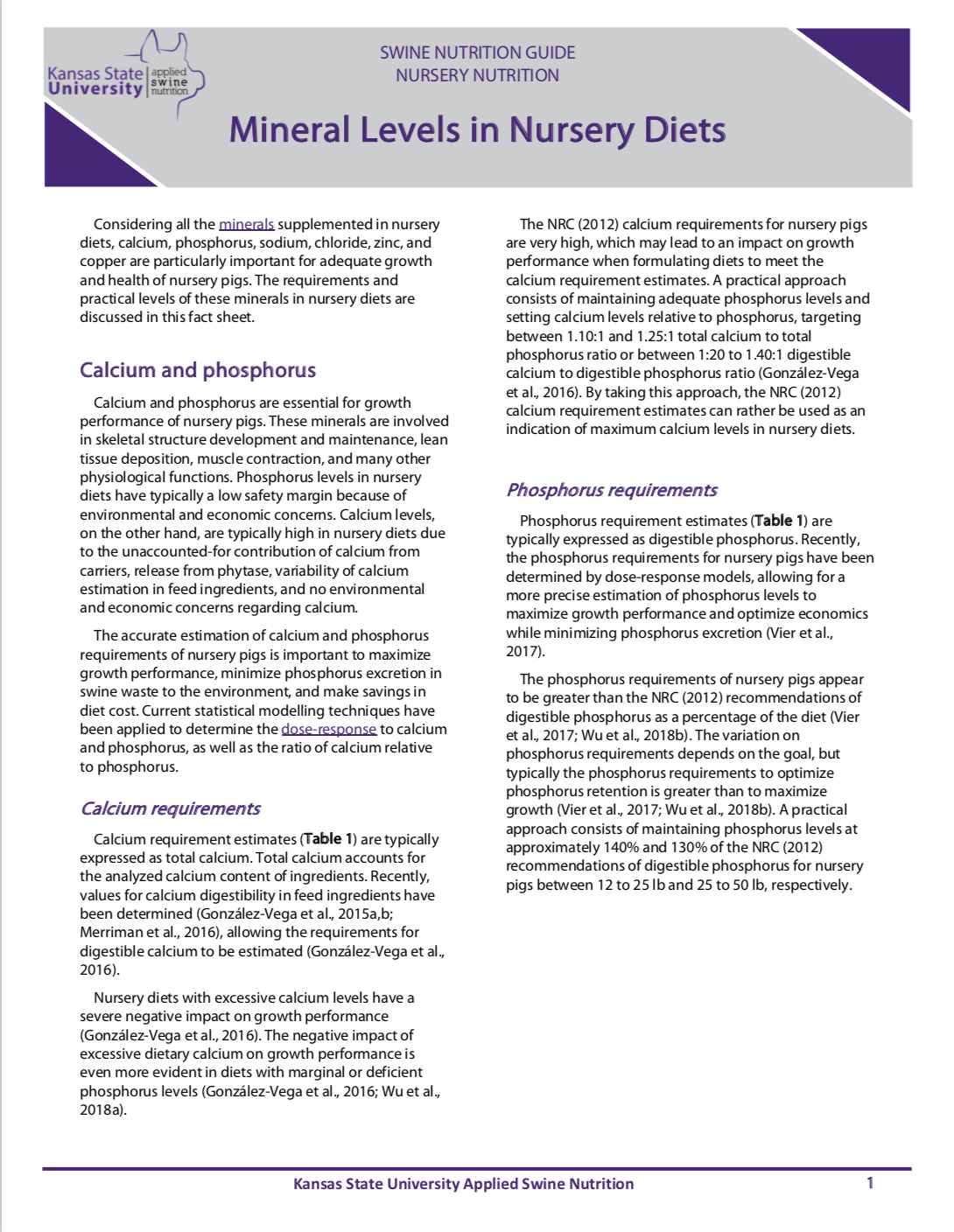Zinc and copper in nursery diets
Zinc and copper are trace minerals required at concentrations of 80 to 100 ppm and 5 to 6 ppm, respectively to meet the requirements of nursery pigs ( Table 1 ). However, the addition of zinc and copper at quantities greater than the requirement exerts a beneficial effect on growth performance of nursery pigs (Liu et al., 2018). Greater quantities of zinc and copper are often referred as growth promoting or pharmacological levels.
Pharmacological levels of dietary zinc between 2,000 and 3,000 ppm is a common recommendation to initial nursery diets to reduce post-weaning diarrhea and improve growth performance (Hill et al., 2000; Shelton et al., 2011). These effects have been consistently demonstrated with dietary zinc provided as zinc oxide (ZnO) (Hill et al., 2001; Hollis et al., 2005; Walk et al., 2015), while zinc sulfate (ZnSO4) has greater potential to induce toxicity (Hahn and Baker, 1993). Organic sources of zinc with greater bioavailability have not consistently demonstrated the same benefits as zinc oxide when organic zinc is added at lower levels (Hahn and Baker, 1993; Carlson et al., 2004; Hollis et al., 2005). However, pharmacological levels of zinc appear to interfere with calcium and phosphorus absorption, prompting the use of phytase or greater levels of calcium and phosphorus in nursery diets to ameliorate this effect (Blavi et al., 2017).
Pharmacological levels of dietary copper between 125 and 250 ppm are commonly used in the diet to enhance fecal consistency and improve growth performance of nursery pigs (Bikker et al., 2016). The most commonly used source of dietary copper is copper sulfate (CuSO4) (Cromwell et al., 1998), but tribasic copper chloride (TBCC) is as effective as copper sulfate in promoting growth performance (Cromwell et al., 1998; Coble et al., 2017). Organic sources of copper with greater bioavailability, such as Cu-amino acid chelate, also seem to have the potential to influence growth performance (Pérez et al., 2011; Carpenter et al., 2018).
A typical recommendation is to use pharmacological levels of zinc in initial nursery diets fed to pigs up to 25 lb and then replace zinc by pharmacological levels of copper for the remaining nursery period ( Table 1 ). Additive effects of using pharmacological levels of zinc and copper are not common (Hill et al., 2000), but might occur to some degree (Pérez et al., 2011). In diets with in-feed antimicrobials, the use of pharmacological levels of zinc or copper seems to have an additive effect in growth performance (Stahly et al., 1980; Hill et al., 2001).
The use of pharmacological levels of zinc and copper poses an environmental concern because of the greater excretion of minerals in swine waste and ultimately in the soil fertilized with swine manure (Jondreville et al., 2003). In addition, the implication of pharmacological levels of zinc and copper as a cause of increasing antimicrobial resistance is a rising concern (Yazdankhah et al., 2014). Therefore, regulations have been implemented in some countries restricting or prohibiting the use of zinc or copper as growth promoters. Thus, there is an appeal for prudent use of pharmacological levels of zinc and copper in swine production.

